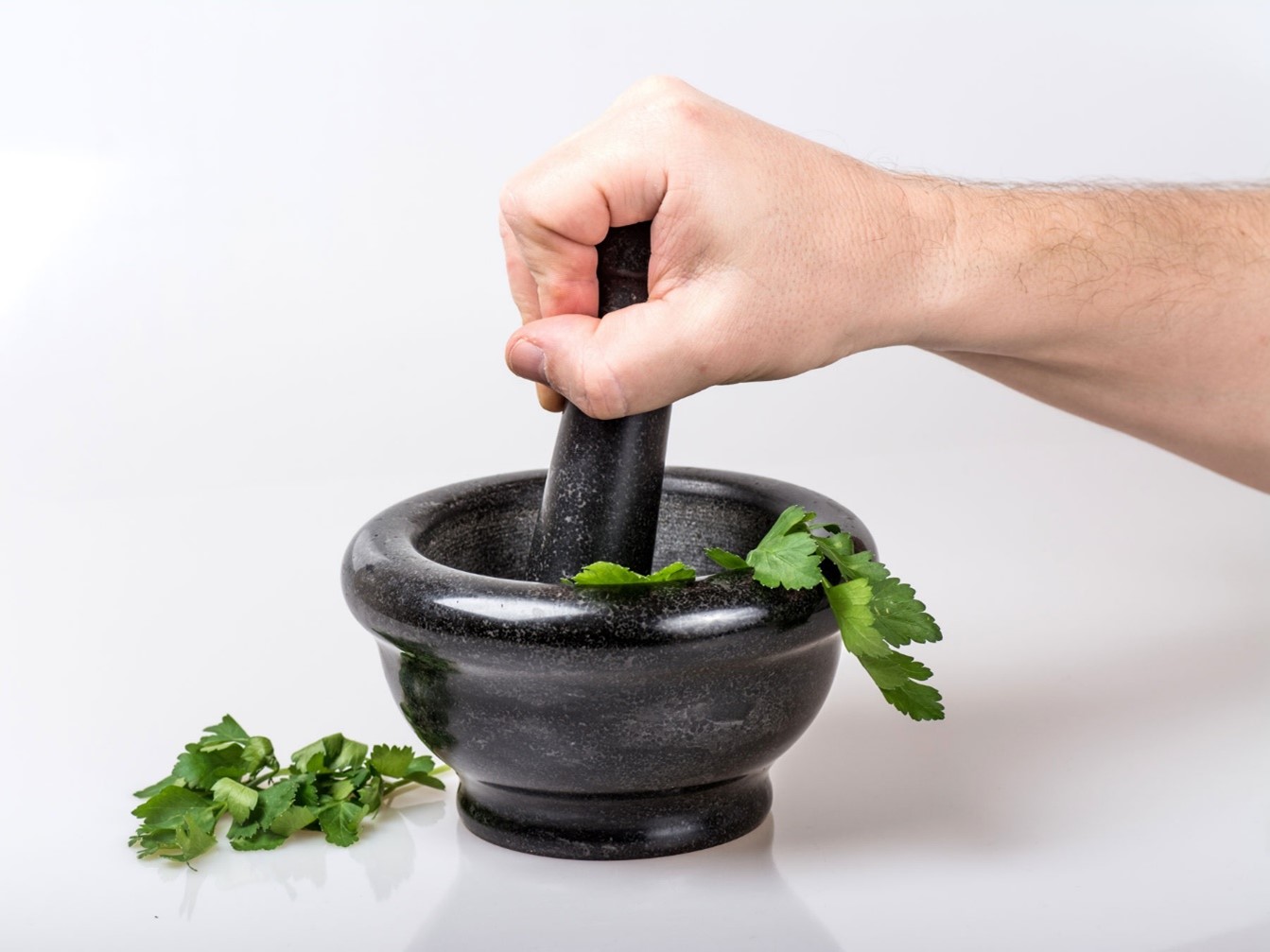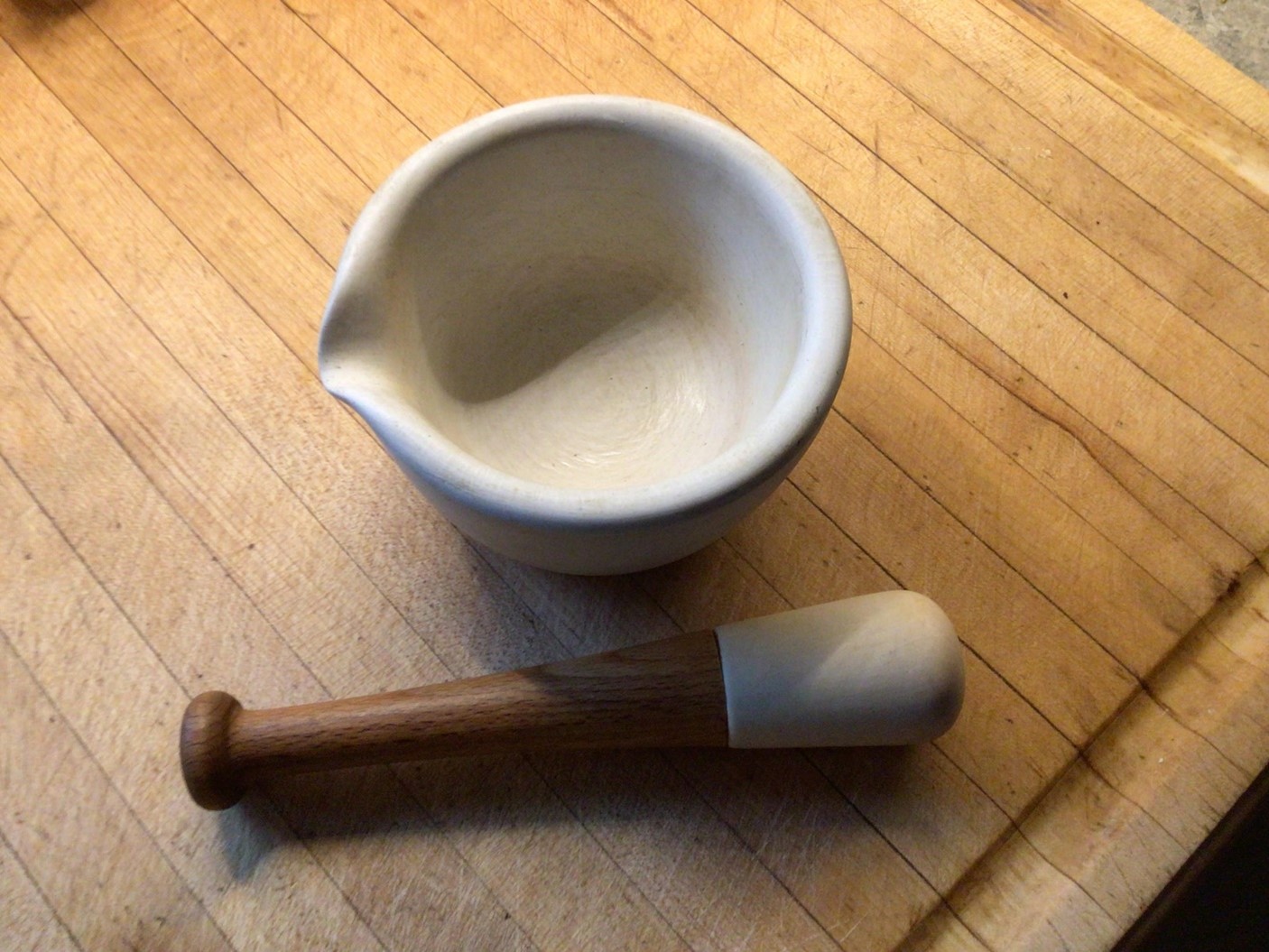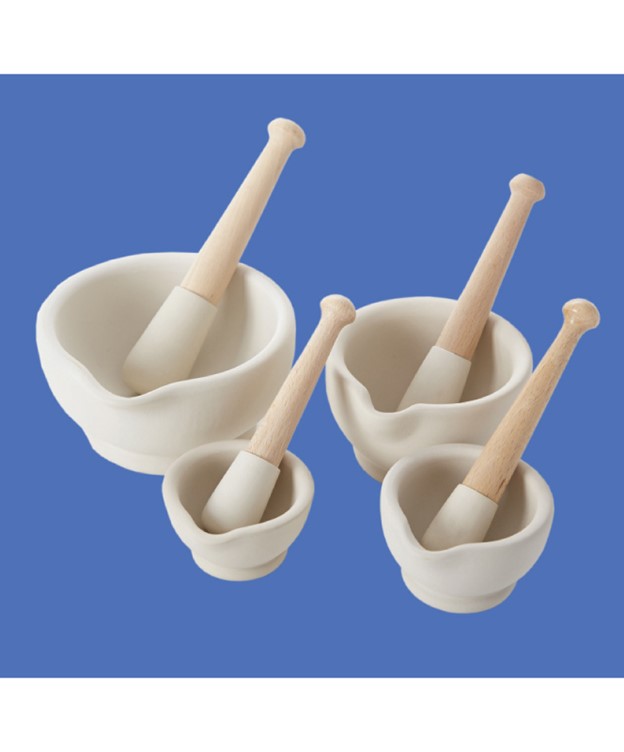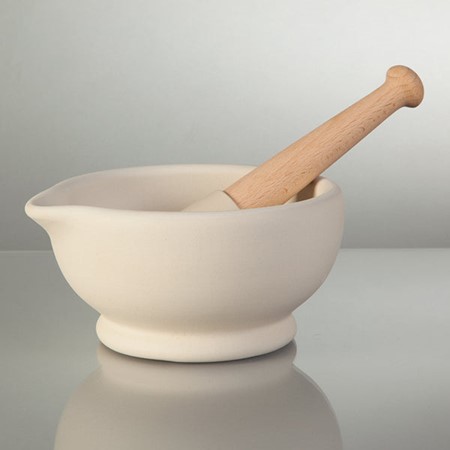Mortar and Pestle Know-How (from Someone Who KNOWS)!
One of the very best features of writing for DVO all these years has been the opportunity to connect with wonderful people (albeit at a distance). I feel we’ve become friends, linked by common interests. And thanks to email, I’ve been blessed by your keen insights and timely suggestions.
One such example of this is an email I received last week from a DVO subscriber (a retired professor of pharmacy from Canada) who said this:
“Strikes me DVO could use an article on mortars and Pestles. It’s common to see cooks (on TV, for instance) struggling with glass or glazed mortars with pestles that are about 3” long. This is nonsense and a waste of time and energy.

“…glazed [or glass] mortars have little grinding power. These are fine for reducing the size of crystals (e.g. salt), and this is their specific purpose. But when you want to reduce whole spices (e.g cloves or allspice), you need something much more abrasive.
“Yes, a glass mortar will eventually pulverize a whole spice, but to work smarter and not harder, you want an unglazed cement-like mortar and pestle—a Wedgwood mortar and pestle.”

The term Wedgewood refers to a type of earthenware pottery introduced in England in 1759 that is still used today to make mortars and pestles. Wedgewood is similar to porcelain, but it is unglazed. It provides a strong grinding surface, and the wood-handled pestle is more durable than its all-porcelain counterparts.
And speaking of pestles, our friend went on to say, “Pestles are another item that needs thought. To be effective, it must “fit” the mortar or it won’t grind properly. There’s an actual size ratio needed between the mortar and the pestle for an efficient and perfect grind to happen.
“Also, the shaft of the pestle should be long enough so it comes out the other side of your fist. This allows you to get a good grip on it. Many pestles have the Wedgwood portion fitted into a wooden handle. My Wedgewood pestle is about 8” long. (See photo below comparing it to a traditional spoon.) It fits perfectly with my mortar which measures 5” in diameter, outside rim to outside rim. These sizes are just right for kitchen use.

“To use, you use the pestle to first shatter the large pieces (cloves, for instance) by pounding vertically up and down. When the spice is sufficiently small, you then grind it to a finer consistency by moving the pestle in a circular motion until the desired size is achieved.
“Wedgewood sets come in different sizes, but you probably won’t find them in a cooking store or gift shop. However, your pharmacist certainly could order a set, or you can order this online at https://totalpharmacysupply.com/wedgewood-mortar-pestles.html.

“Lastly,” our professor friend says, “this equipment should be hand washed.” I’ll just add that because it is porous, it’s helpful to take a toothbrush or vegetable brush to it to be sure you’re removing all traces of the herb or spice you’ve been grinding.
The Wedgewood mortar and pestle does cost more than what you’ll find at Walmart or a kitchen specialty store. But I’m taking our friend’s expertise and advice to heart—I believe we get what we pay for and the extra cost will be well worth it.
His interesting and helpful email concluded with this: “If you would like an American reference on mortars and pestles, a book produced by the Philadelphia School of Pharmacy entitled REMINGTON’S PHARMACEUTICAL SCIENCE has an entire chapter on the subject. This book also covers just about every aspect of pharmacy and so is most interesting even to the layman (how gelatine capsules are made and sized, for instance).”

I want to thank our Canadian friend for going to the effort to share this mortar and pestle know-how. It was not just delightful to read, but enlightening! Cook’n readers are the BEST! (And I’m ordering my Wedgewood mortar and pestle next payday!)
One such example of this is an email I received last week from a DVO subscriber (a retired professor of pharmacy from Canada) who said this:
“Strikes me DVO could use an article on mortars and Pestles. It’s common to see cooks (on TV, for instance) struggling with glass or glazed mortars with pestles that are about 3” long. This is nonsense and a waste of time and energy.

“…glazed [or glass] mortars have little grinding power. These are fine for reducing the size of crystals (e.g. salt), and this is their specific purpose. But when you want to reduce whole spices (e.g cloves or allspice), you need something much more abrasive.
“Yes, a glass mortar will eventually pulverize a whole spice, but to work smarter and not harder, you want an unglazed cement-like mortar and pestle—a Wedgwood mortar and pestle.”

The term Wedgewood refers to a type of earthenware pottery introduced in England in 1759 that is still used today to make mortars and pestles. Wedgewood is similar to porcelain, but it is unglazed. It provides a strong grinding surface, and the wood-handled pestle is more durable than its all-porcelain counterparts.
And speaking of pestles, our friend went on to say, “Pestles are another item that needs thought. To be effective, it must “fit” the mortar or it won’t grind properly. There’s an actual size ratio needed between the mortar and the pestle for an efficient and perfect grind to happen.
“Also, the shaft of the pestle should be long enough so it comes out the other side of your fist. This allows you to get a good grip on it. Many pestles have the Wedgwood portion fitted into a wooden handle. My Wedgewood pestle is about 8” long. (See photo below comparing it to a traditional spoon.) It fits perfectly with my mortar which measures 5” in diameter, outside rim to outside rim. These sizes are just right for kitchen use.

“To use, you use the pestle to first shatter the large pieces (cloves, for instance) by pounding vertically up and down. When the spice is sufficiently small, you then grind it to a finer consistency by moving the pestle in a circular motion until the desired size is achieved.
“Wedgewood sets come in different sizes, but you probably won’t find them in a cooking store or gift shop. However, your pharmacist certainly could order a set, or you can order this online at https://totalpharmacysupply.com/wedgewood-mortar-pestles.html.

“Lastly,” our professor friend says, “this equipment should be hand washed.” I’ll just add that because it is porous, it’s helpful to take a toothbrush or vegetable brush to it to be sure you’re removing all traces of the herb or spice you’ve been grinding.
The Wedgewood mortar and pestle does cost more than what you’ll find at Walmart or a kitchen specialty store. But I’m taking our friend’s expertise and advice to heart—I believe we get what we pay for and the extra cost will be well worth it.
His interesting and helpful email concluded with this: “If you would like an American reference on mortars and pestles, a book produced by the Philadelphia School of Pharmacy entitled REMINGTON’S PHARMACEUTICAL SCIENCE has an entire chapter on the subject. This book also covers just about every aspect of pharmacy and so is most interesting even to the layman (how gelatine capsules are made and sized, for instance).”

I want to thank our Canadian friend for going to the effort to share this mortar and pestle know-how. It was not just delightful to read, but enlightening! Cook’n readers are the BEST! (And I’m ordering my Wedgewood mortar and pestle next payday!)
 Alice Osborne
Alice Osborne
Weekly Newsletter Contributor since 2006
Email the author! alice@dvo.com
